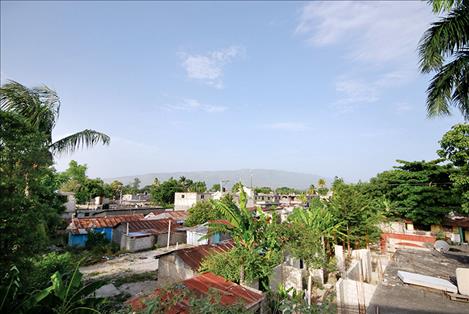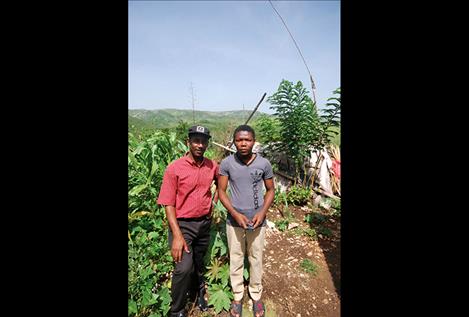Neighbors on call
As Montana begins training new community health workers, Haiti may offer a window to the state’s healthcare future
Hey savvy news reader! Thanks for choosing local.
You are now reading
1 of 3 free articles.
Part 3: This is the third part of a three-part story on the role of community health workers in rural health care from the Montana Gap project.
Two months ago, the boys played like children do, clambering around a ruined building just down the lush green hillside from their home. Now their mom, Moslene, cooks only for her husband, a mechanical act that brings her no joy. Only sadness and a remembrance of the innocent laughter she will never hear again. Her boys — her only children — are dead. A wall of that ruined building fell on them, killing them instantly.
Moslene’s house, a one-story, two-room concrete structure with a wrap-around porch and faded blue and white paint, is noiseless in the muggy morning heat. Her husband is down in the garden. He’s always in the garden. Not long ago, he spoke of drinking poison.
Moslene sits sideways on a highbacked chair beneath the fruit trees in her small dirt yard, her shoulder pressed against the dark wood, legs drawn up and crossed at the ankles. She wipes at her tears with the hem of her shirt and speaks in short snatches of Haitian Creole, just a few words at a time. Joseph Benissois, the community health worker with Zanmi Lasante/Partners In Health, does not touch or console her. He does not smile. He asks her questions from a list on a clipboard in his lap, his voice a deep, uninflected baritone.
Does she cry often? Yes. When she sees the other children walking to school, or hears them playing nearby. “Almost every day.” Does she have difficulty sleeping? The suffering is not as bad at night. But sometimes she dreams. “She sees them in her dreams, playing, playing, and she knows this is not right,” our translator relays.
Does she feel bad or uncomfortable with herself? She doesn’t eat, doesn’t feel like herself. “She’s trying to remove this remembrance in her mind, but she can’t.”
In the past 15 days, has she wanted to die? “She prefers to die in the place of her sons, but that’s life.”
Benissois has been checking up on Moslene and her husband every two weeks since their sons, 8 and 10, died. Benissois has already referred her to a psychiatrist at the ZL/PIH clinic in Cange. She has an appointment in six days, her second since the accident. When he’s finished with the questions, Benissois reviews relaxation methods with Moslene, shaking his arms, massaging his thighs with his palms, inhaling through his nose and exhaling through his mouth. Moslene listens but does not participate. As Benissois rises to leave, she gathers up chairs, then retreats through a side door into her darkened home.
Benissois’ work with Presandieu Charles, Moslene and others in the Cange area is a prime example of how CHWs can serve to redistribute the pressure normally placed on healthcare specialists and the places they work. Yes, Charles receives treatment from Dr. Fils Aime. But his gradual recovery within his village is largely left to Benissois to monitor.
Adding CHWs to Haiti’s healthcare equation has proven promising enough that ZL/PIH has exported the model to project sites in Rwanda, Malawi, Sierra Leone and Chiapas, Mexico. Père Eddy Eustache, ZL/PIH’s mental-health director in Mirebalais, notes that there’s “huge enthusiasm” across the globe today about the work being done by CHWs. However, he cautions that such programs need to be community- driven, and that a CHW’s first loyalty must first be to their communities.
On the Navajo Nation, they’re known as community health representatives. Isolation is as big a hurdle here as anywhere in the western United States, with tribal members scattered across 27,000 square miles of New Mexico, Arizona and Utah. When the program launched with the help of federal funding in 1968, the vision was essentially identical to that in Haiti and elsewhere: Train and task trusted locals to staff healthcare’s frontlines. Now the Navajo program operates with a $6.5 million annual budget and employs more than 70 community workers. In 2009, the Navajo Nation partnered with several organizations including Partners in Health to form the nonprofit Community Outreach & Patient Empowerment (COPE). A community health rep’s duties can range from taking vital signs and helping people get follow-up appointments with specialists to assessing home weatherization and educating people about outbreaks like West Nile virus.
“You’ll have one CHR that might be overseeing a community that has about 200 community members [and] one CHR overseeing a community that has close to 4,000 individuals,” says COPE Community Outreach Manager Olivia Muskett.
But if the Navajo Nation’s CHR program offers Montana a glimpse of anything, it’s what 50 years of evolution can lead to. Since the early 1990s, the program has required that CHR applicants possess a Certified Nursing Assistant Certificate, a qualification that takes, on average, four to eight weeks to acquire and is beyond what Montana’s new training currently requires. Muskett says the requirement is a reflection of how integrated CHRs have become in the Navajo Nation’s healthcare system. COPE has also in recent years begun organizing monthly trainings and case-management meetings to strengthen relationships between CHRs and hospital-based providers.
Despite the decades, CHR training on the Navajo Nation has only recently started to tackle mental health issues head-on. All CHRs were sent through a mental-health first-aid course a couple of years ago, Muskett says, in response to increased rates of suicide in several of the places they serve. A few have been specifically assigned to mental- health teams, but PIH and the tribal health department are still discussing how to better incorporate mental health into community- health work, including adding lessons about cognitive behavioral therapy. According to a 2015 policy report by the University of Arizona, only 31 percent of CHR programs on Indian reservations in the U.S. reported focusing on behavioral or mental health, though 60 percent of those programs stated that their CHRs could benefit from formal training in substance abuse, behavioral health and lifestyle coaching.
“If you’re talking to community members about diabetes or their chronic illness, then you should include in that conversation the mental health issue that is associated,” Muskett says. “The individual is dealing with their illness, and of course they’re going to have some emotional tie to that and some mental tie to that.”
As with research elsewhere, studies on the Navajo Nation frequently cite familiarity with local values, beliefs and social dynamics — and the consequent ability to build patient trust — as among a CHR’s strongest assets. Like Benissois in Haiti, community- based health workers the world over know all too well the social, financial and geographic challenges that those suffering from mental- health issues face. As Eustache says, CHRs are “sharing the daily life of the people.” It’s no different in Montana.
Back in Haiti, ask Benissois why he does this work and you’ll get a shrug. His mustache will curl up at the corners. He will tell you it is his “pleasure” to help people. Then he will continue along the bustling roadside in silence, as if that’s answer enough.
Eustache’s response is almost equally succinct: “Money can be a motivating factor,” he says. “But you may find as well people who want to be more active and more supportive to their community and very sensitized to their community progress.”
Perhaps, as CHW training begins in Montana, Benissois’ smile and Eustache’s altruism offer some hint at who here will step up to help.
This story has been supported by the Solutions Journalism Network, a nonprofit organization dedicated to rigorous and compelling reporting about responses to social problems. SolutionsJournalism.org

















